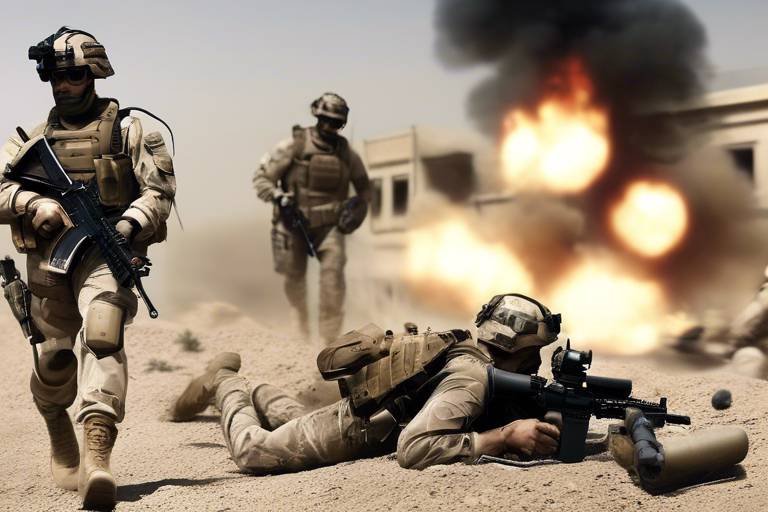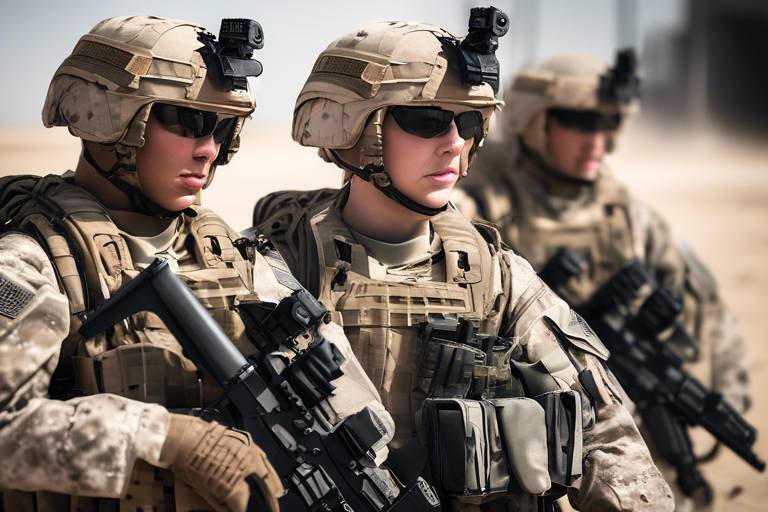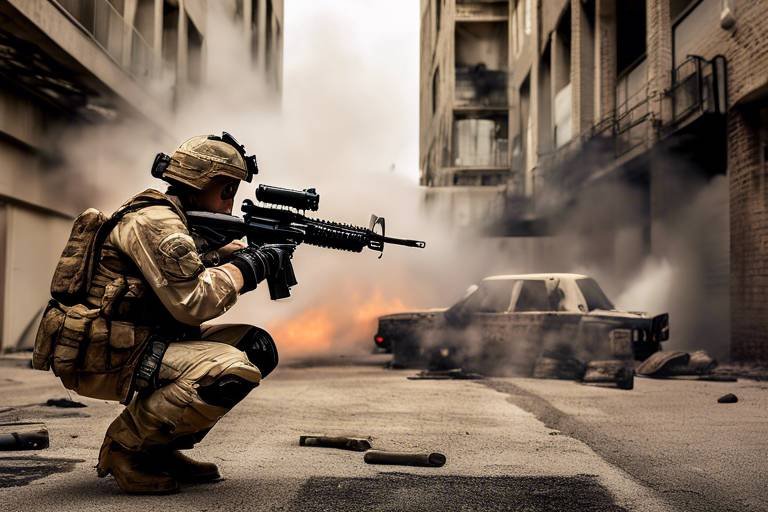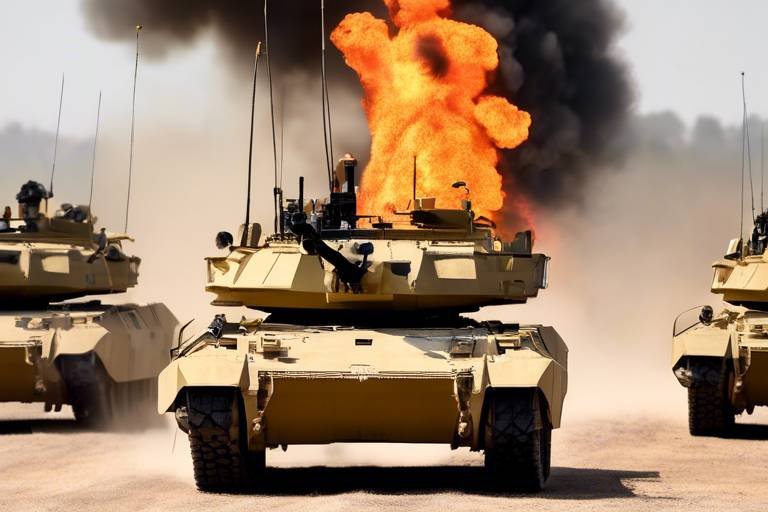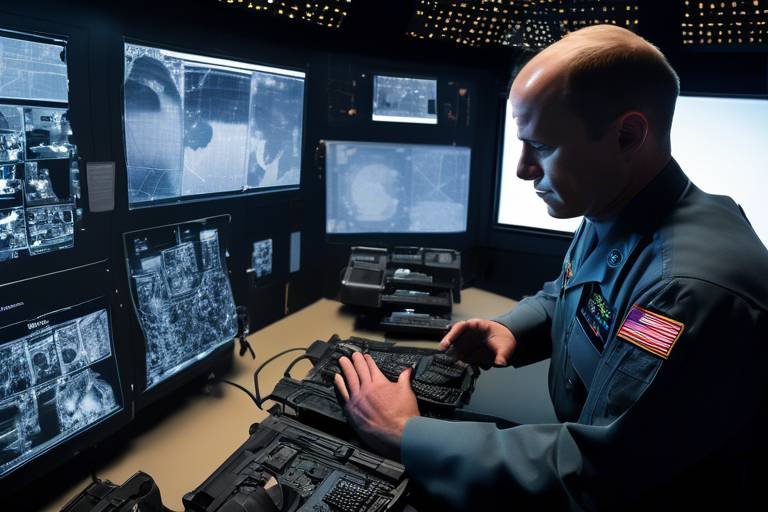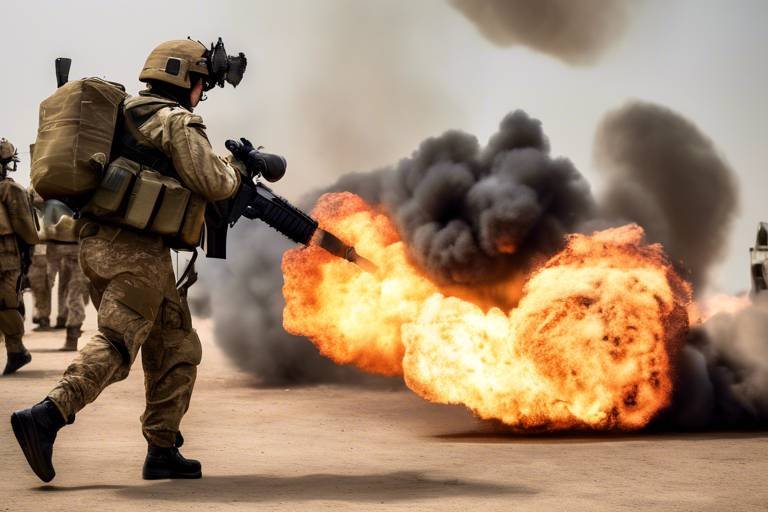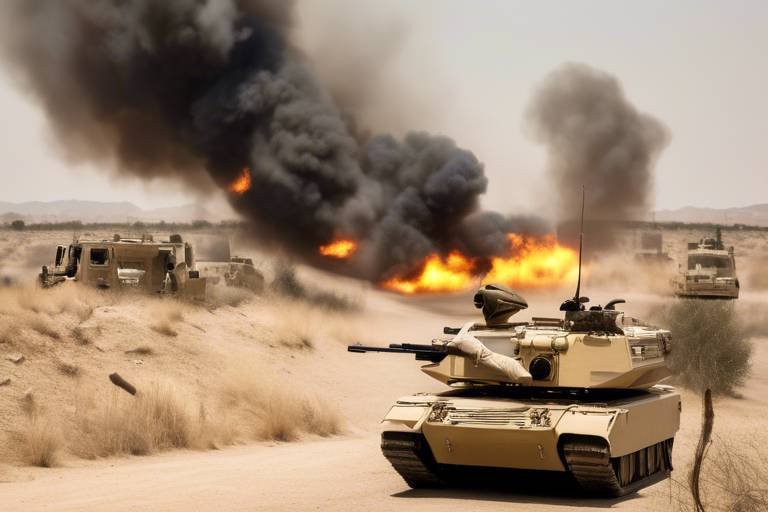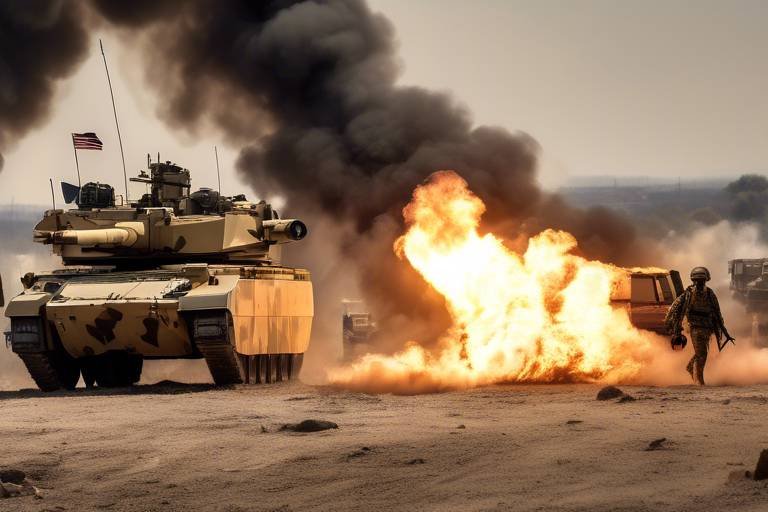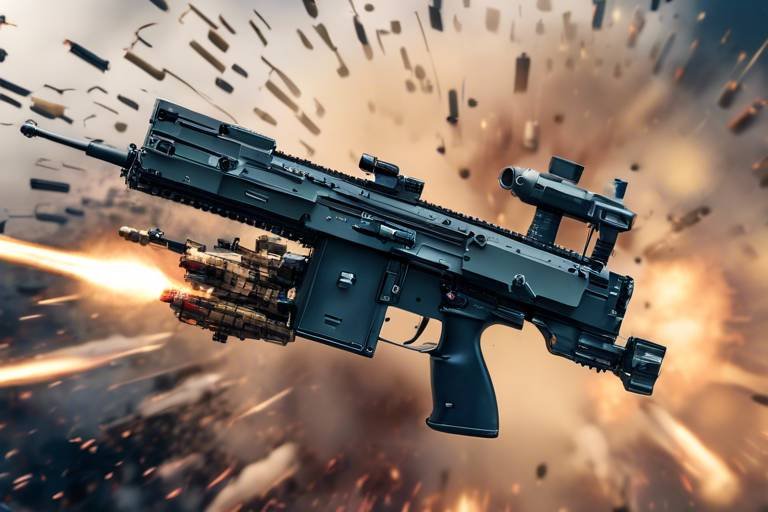Understanding the Integration of Ground Forces and Firepower
In the realm of modern warfare, the integration of ground forces and firepower is not just a strategy; it’s a necessity. Imagine a well-orchestrated symphony where every instrument plays its part to create a masterpiece. This is precisely how ground forces and firepower work together on the battlefield. The synergy between these two elements can significantly enhance military effectiveness and operational success, especially in complex combat scenarios. Understanding this relationship is crucial for military strategists and enthusiasts alike, as it reveals the intricacies of how battles are won or lost.
Ground forces are the backbone of military operations, tasked with securing and holding territory. Think of them as the sturdy foundation of a house; without a solid base, everything else can crumble. The primary functions of ground forces include engaging enemy troops, conducting reconnaissance, and securing vital locations. Their capabilities extend beyond mere presence; they are equipped with advanced technology and weaponry that enable them to adapt to various combat situations. However, it’s not just about having the right tools; training and organization are paramount. Well-trained soldiers who can operate cohesively as a unit are more likely to succeed in the chaos of battle.
Firepower is a broad term that encompasses various weapon systems, each designed for specific strategic applications on the battlefield. From artillery and air support to missile systems, understanding the types of firepower available is essential for effective military operations. Each type has its unique advantages and can be utilized in different scenarios to achieve maximum impact. For instance, artillery can provide devastating long-range support, while air power can deliver rapid strikes to disrupt enemy formations. The key lies in knowing when and how to deploy these resources effectively.
Artillery serves as a critical component in modern warfare, providing long-range fire support to ground troops. It can be likened to a heavy hammer in a toolbox, delivering powerful blows to enemy positions from a distance. The types of artillery used can vary widely, from traditional howitzers to advanced rocket systems. Each type plays a distinct role in supporting ground operations and can significantly impact enemy forces. For instance, a well-placed artillery barrage can demoralize the enemy, disrupt their plans, and create openings for ground troops to advance.
When comparing howitzers and mortars, it's essential to understand their unique advantages and operational roles. Howitzers are designed for long-range fire, capable of launching shells over significant distances with high explosive power. They are ideal for engaging fortified positions and providing sustained fire support. On the other hand, mortars are short-barreled, portable artillery pieces that can fire shells at high angles. Their ability to deliver indirect fire makes them effective for targeting hidden or protected enemy forces. Both have their place in the battlefield, and understanding when to use each can be the difference between victory and defeat.
In an age where collateral damage is a significant concern, precision artillery strikes have become increasingly important. These strikes aim to minimize unintended damage while maximizing impact on enemy forces. Utilizing advanced technology, such as GPS-guided munitions, military forces can strike with pinpoint accuracy. This not only conserves resources but also helps in maintaining the moral high ground during conflicts. The strategies behind effective precision targeting are complex and involve meticulous planning and coordination with ground forces to ensure that every shot counts.
Air support plays a vital role in enhancing the effectiveness of ground operations. Imagine a bird's-eye view of the battlefield; air power provides critical intelligence and fire support that can turn the tide of battle. However, the integration of air support with ground forces requires seamless coordination. Effective joint operations rely on communication and shared objectives to ensure that air strikes complement ground maneuvers rather than hinder them. This integration can lead to overwhelming force against the enemy, showcasing the power of combined arms in modern warfare.
Joint operations represent the collaboration of various military branches, combining the strengths of each to achieve a common goal. This approach can be likened to a sports team, where each player has a unique role, but together they create a formidable force. The benefits of integrating ground forces with air and naval power include increased operational flexibility and enhanced situational awareness. However, the challenges are equally significant, as differences in protocols and communication systems can lead to confusion and inefficiency.
Effective communication is the linchpin of successful joint operations. In the heat of battle, clear and concise communication can mean the difference between life and death. Modern military operations rely on advanced technologies and protocols that facilitate coordination between ground and air forces. From secure radio communications to satellite links, these systems ensure that all units are on the same page. The ability to share real-time intelligence and updates allows for rapid decision-making and adaptability in dynamic combat environments.
Analyzing historical case studies provides invaluable insights into the successes and failures of integrating ground forces and firepower. Each case offers lessons that can inform future military strategies. For example, during World War II, the coordination between ground troops and air support was pivotal in several campaigns, demonstrating the effectiveness of joint operations. Conversely, there have been instances where poor communication and lack of coordination led to disastrous outcomes. These lessons underscore the importance of continuous improvement in tactics and strategies.
- What is the primary role of ground forces in military operations? Ground forces are essential for securing and holding territory, engaging enemy troops, and conducting reconnaissance.
- How does artillery support ground troops? Artillery provides long-range fire support, helping to disrupt enemy positions and create openings for ground forces to advance.
- What are precision strikes? Precision strikes are targeted attacks designed to minimize collateral damage while maximizing impact on enemy forces.
- Why is communication important in joint operations? Effective communication ensures that all military branches work together seamlessly, reducing confusion and increasing operational effectiveness.
The Role of Ground Forces
Ground forces are the backbone of any military operation, acting as the primary means of securing and holding territory. They are the boots on the ground, the individuals who engage in direct combat, and the ones who often bear the brunt of warfare. Their role is not just about brute strength; it's about strategy, coordination, and the ability to adapt to ever-changing battlefield conditions. Ground forces are equipped with a range of capabilities, from infantry units trained in close combat to armored divisions that can maneuver through hostile terrain. This versatility is crucial in modern warfare, where the dynamics of combat can shift rapidly.
In addition to their combat capabilities, ground forces are essential for establishing and maintaining control over areas that have been secured. This includes not only engaging enemy forces but also managing logistics, conducting reconnaissance, and providing humanitarian assistance in post-conflict scenarios. The importance of training and organization cannot be overstated; well-coordinated units can execute complex maneuvers that enhance their effectiveness on the battlefield. For example, in urban warfare, ground forces must be adept at navigating through tight spaces while minimizing civilian casualties, which requires extensive preparation and drills.
Moreover, the integration of various support elements, such as artillery and air support, significantly amplifies the effectiveness of ground troops. When ground forces are well-trained to work alongside these supporting units, they can leverage firepower to gain a decisive advantage over the enemy. This synergy is not just about having the right equipment; it involves a deep understanding of tactics and communication protocols. Ground forces must be able to relay real-time information about enemy positions and movements, ensuring that fire support can be effectively directed where it is needed most.
To illustrate the multifaceted role of ground forces, consider the following key functions:
- Combat Engagement: Directly engaging enemy forces to neutralize threats.
- Territory Control: Securing and holding strategic locations to deny enemy access.
- Logistics and Support: Managing supplies and resources to sustain operations.
- Humanitarian Assistance: Providing aid and support to civilian populations affected by conflict.
In summary, ground forces play a crucial role in military effectiveness. Their ability to adapt, coordinate, and integrate with other military branches enhances operational success in complex combat scenarios. As warfare continues to evolve, the importance of ground forces remains steadfast, underscoring the need for continuous training and development to meet the challenges of modern conflict.
Types of Firepower
When we think about military operations, the term firepower often comes to mind as a critical element that shapes the battlefield. Firepower isn't just about the loud booms and flashes of light; it's a complex array of weapon systems designed to achieve specific strategic objectives. Understanding the different types of firepower is essential for grasping how modern warfare operates. From artillery to air support and advanced missile systems, each type plays a unique role in enhancing the effectiveness of ground forces.
At its core, firepower can be categorized into three main types: direct fire, indirect fire, and air support. Each type has distinct characteristics and applications on the battlefield. Direct fire includes weapons like rifles and machine guns, where the shooter aims directly at the target. In contrast, indirect fire involves launching projectiles that travel in a high arc, allowing them to hit targets that are not in the direct line of sight. This is where artillery comes into play, providing crucial support to ground troops.
The integration of these firepower types is what truly enhances military effectiveness. For instance, when ground forces are engaged in combat, they often rely on artillery support to suppress enemy positions. This can be a game changer, allowing troops to advance while minimizing their exposure to enemy fire. Furthermore, the coordination between ground forces and air support is vital. Air power can deliver rapid strikes against enemy forces, disrupting their operations and providing ground troops with the upper hand.
| Type of Firepower | Description | Examples |
|---|---|---|
| Direct Fire | Weapons aimed directly at a target. | Rifles, Machine Guns |
| Indirect Fire | Weapons that launch projectiles at high angles. | Artillery, Mortars |
| Air Support | Aircraft providing support to ground forces. | Bombers, Attack Helicopters |
In addition to these categories, advancements in technology have led to the development of precision strike capabilities. This means that firepower can now be delivered with remarkable accuracy, significantly reducing collateral damage while maximizing impact on enemy forces. Precision-guided munitions (PGMs) are a prime example of this evolution, allowing military planners to strike specific targets with minimal risk to surrounding areas.
As we delve deeper into the various types of firepower, it's essential to recognize how these elements work together. The synergy between ground forces and their firepower not only enhances operational success but also contributes to the overall strategy of military engagements. By leveraging the strengths of each firepower type, commanders can create a more dynamic and responsive force capable of adapting to the ever-changing battlefield landscape.
In conclusion, understanding the types of firepower available to military forces is crucial for comprehending modern warfare. The integration of direct fire, indirect fire, and air support creates a multifaceted approach to combat that enhances the effectiveness of ground troops. As technology continues to evolve, the capabilities of firepower will only expand, providing military strategists with even more tools to achieve their objectives.
Artillery Support
Artillery support is a cornerstone of modern military operations, providing the necessary long-range firepower that can significantly alter the dynamics of a battlefield. Imagine being on the ground, facing an enemy entrenched in fortified positions. The ability to call in artillery fire can mean the difference between success and failure in a mission. Artillery units, equipped with powerful weapon systems, are designed to deliver devastating firepower from a distance, allowing ground forces to advance with reduced risk of casualties.
There are several types of artillery systems, each with unique capabilities and roles. These include howitzers, mortars, and rocket artillery, all of which play critical roles in supporting ground troops. For instance, howitzers are known for their versatility and range, capable of firing shells at both high and low angles, making them suitable for various combat scenarios. Mortars, on the other hand, are often used for indirect fire at shorter ranges, providing rapid response capabilities to ground forces. Rocket artillery systems can deliver a large volume of firepower quickly, which is especially useful in suppressing enemy positions or providing cover for advancing troops.
One of the most significant advantages of artillery support is its ability to conduct indirect fire. This means that artillery units can engage targets that are not in the direct line of sight, often hidden behind obstacles or in difficult terrain. The precision and effectiveness of artillery fire have improved dramatically with advancements in technology. Modern artillery systems are equipped with sophisticated targeting systems that enhance accuracy and minimize collateral damage. For example, GPS-guided munitions allow for pinpoint strikes on enemy positions, which not only protects friendly forces but also limits unintended damage to civilian infrastructure.
To illustrate the impact of artillery support, consider the following table that summarizes the key features of different artillery systems:
| Artillery Type | Range | Payload | Usage |
|---|---|---|---|
| Howitzer | 15-30 km | Shells (various types) | Versatile, long-range support |
| Mortar | 2-7 km | High-explosive shells | Close support, rapid response |
| Rocket Artillery | 20-100 km | Multiple rocket pods | Massive firepower, area suppression |
Artillery support is not just about firepower; it also requires meticulous planning and coordination with ground forces. The effectiveness of artillery strikes is heavily reliant on accurate intelligence and communication. Ground troops often work closely with forward observers who can relay real-time information about enemy positions to artillery units. This collaboration ensures that artillery fire is both timely and effective, allowing ground forces to exploit the gaps created by artillery strikes.
However, the integration of artillery support comes with its challenges. The terrain, weather conditions, and the mobility of both friendly and enemy forces can all influence the effectiveness of artillery operations. Moreover, the risk of friendly fire is a constant concern, necessitating stringent protocols and communication between ground and artillery units. Training plays a vital role in mitigating these risks, as soldiers must be well-versed in both the capabilities of their artillery systems and the tactics employed by ground forces.
In conclusion, artillery support remains a vital component of military operations, providing the firepower needed to shape the battlefield and support ground forces in achieving their objectives. As technology continues to evolve, the integration of artillery into joint operations will only become more sophisticated, enhancing the effectiveness of military strategies worldwide.
- What is the primary role of artillery support in military operations? Artillery support provides long-range firepower to assist ground forces in engaging enemy positions and securing territory.
- How has technology impacted artillery support? Advancements in technology, such as GPS-guided munitions, have improved the accuracy and effectiveness of artillery strikes while reducing collateral damage.
- What are the main types of artillery systems? The main types include howitzers, mortars, and rocket artillery, each serving different roles and capabilities on the battlefield.
- How do ground forces coordinate with artillery units? Ground forces work with forward observers who relay real-time intelligence to artillery units, ensuring effective and timely strikes.
Howitzers vs. Mortars
When it comes to the artillery used in modern warfare, two heavyweights often come to mind: howitzers and mortars. Both serve critical roles on the battlefield, yet their functionalities, advantages, and tactical applications differ significantly. Understanding these differences can provide valuable insights into military strategies and ground force support.
Howitzers are versatile artillery pieces capable of firing shells at both high and low angles. They are designed for long-range bombardment, making them ideal for delivering powerful strikes against enemy positions from a distance. With a typical range of up to 30 kilometers or more, howitzers can engage targets that are well beyond the frontline, providing essential fire support for ground troops. Their ability to fire various types of ammunition, including high-explosive, smoke, and precision-guided munitions, allows commanders to adapt to different combat scenarios effectively.
On the other hand, mortars are shorter-barreled, portable artillery systems that excel in delivering indirect fire at steep angles. They are typically used for close support operations, engaging targets that are often obscured from direct line of sight. Mortars come in various calibers, with the most common being 60mm, 81mm, and 120mm. Their lightweight design enables rapid deployment and repositioning, making them suitable for infantry units that require immediate fire support during combat. Mortars are particularly effective in urban warfare, where their ability to deliver high-angle fire allows them to hit targets in confined spaces.
To further illustrate the differences between howitzers and mortars, here’s a quick comparison:
| Feature | Howitzers | Mortars |
|---|---|---|
| Range | Up to 30 km or more | Typically up to 5 km |
| Firing Angle | High and low angles | Steep angles |
| Mobility | Less mobile, often towed or self-propelled | Highly mobile, often man-portable |
| Typical Use | Long-range bombardment | Close support and indirect fire |
While both howitzers and mortars have their unique strengths, the choice between the two often depends on the specific tactical situation. For instance, in a scenario where ground forces need to suppress enemy fire from a distance, howitzers would likely be the preferred option. Conversely, in close-quarters combat where rapid and flexible fire support is paramount, mortars would shine due to their portability and ability to deliver quick strikes.
In conclusion, understanding the roles of howitzers and mortars is crucial for military strategists. Each artillery type complements the other, and their effective integration into ground operations can significantly enhance combat effectiveness. As warfare continues to evolve, so too will the tactics surrounding these powerful tools, ensuring that ground forces remain equipped to face any challenge.
- What is the main difference between howitzers and mortars? Howitzers are designed for long-range bombardment with a versatile firing angle, while mortars are used for close support with steep firing angles.
- Which artillery piece is more mobile? Mortars are generally more mobile due to their lightweight design, allowing for quick repositioning on the battlefield.
- Can howitzers and mortars be used together? Yes, they can complement each other effectively, with howitzers providing long-range support while mortars offer close-in fire support.
Precision Strikes
In the realm of modern warfare, have emerged as a game-changer, revolutionizing how military operations are conducted. Gone are the days of indiscriminate bombings that often resulted in collateral damage and civilian casualties. Today, the focus is on accuracy and efficiency, ensuring that the right targets are hit with minimal repercussions. But what exactly makes precision strikes so effective?
At the heart of precision strikes lies advanced technology. The integration of sophisticated targeting systems, such as GPS-guided munitions and laser-guided bombs, allows military forces to engage targets with pinpoint accuracy. For instance, the use of Joint Direct Attack Munitions (JDAM) has transformed conventional bombs into smart munitions, capable of striking within a few meters of their intended target. This level of accuracy not only reduces collateral damage but also enhances the overall effectiveness of military operations.
Moreover, the coordination between ground forces and air support is crucial in executing successful precision strikes. Effective communication ensures that air assets are deployed at the right moment, allowing for synchronized attacks that overwhelm enemy defenses. Imagine a well-rehearsed dance, where each participant knows their role and timing—this is how joint operations should function when executing precision strikes.
One of the most significant advantages of precision strikes is their ability to minimize collateral damage. In urban combat scenarios, where civilians and critical infrastructure are often in close proximity to military targets, the stakes are incredibly high. By employing precision-guided munitions, military forces can significantly reduce the risk to non-combatants. This not only preserves the local population but also aids in maintaining the legitimacy of military operations in the eyes of the international community.
Furthermore, the psychological impact of precision strikes cannot be overlooked. When adversaries realize that their positions can be targeted with such accuracy, it instills a sense of fear and uncertainty. This can lead to a breakdown in morale and cohesion among enemy forces, as they become increasingly aware that they are being watched and targeted at all times.
To illustrate the effectiveness of precision strikes, consider the following table that highlights key technologies and their impact:
| Technology | Description | Impact on Operations |
|---|---|---|
| GPS-Guided Munitions | Munitions equipped with GPS for accurate targeting. | Increased strike accuracy and reduced collateral damage. |
| Laser-Guided Bombs | Bombs that use laser guidance for precision targeting. | Ability to hit moving targets with high accuracy. |
| Drone Strikes | Unmanned aerial vehicles (UAVs) used for targeted strikes. | Real-time surveillance and precise engagement of targets. |
In conclusion, precision strikes are not just about the technology; they represent a fundamental shift in military strategy. As warfare continues to evolve, the ability to strike accurately and efficiently will be paramount. The combination of advanced technology, effective communication, and psychological warfare creates a formidable force on the battlefield. As we look to the future, one thing is clear: precision strikes will remain a critical component of military operations, shaping the landscape of modern warfare.
- What are precision strikes? Precision strikes refer to military attacks that are executed with a high degree of accuracy, minimizing collateral damage and maximizing effectiveness.
- How do precision strikes reduce collateral damage? By utilizing advanced targeting technologies, such as GPS and laser guidance, military forces can hit specific targets without affecting nearby civilians or infrastructure.
- Why are precision strikes important in modern warfare? They enhance operational effectiveness, preserve civilian lives, and maintain the legitimacy of military operations.
- What technologies are commonly used for precision strikes? Common technologies include GPS-guided munitions, laser-guided bombs, and drone strikes.
Air Support Integration
When we think about modern warfare, the image of ground troops advancing under the cover of air support is a powerful one. is not just about having fighter jets soaring overhead; it's about creating a seamless partnership between ground forces and aerial units. This relationship is crucial for operational success, especially in complex combat scenarios. The synergy between these two elements can turn the tide of battle, allowing ground forces to maneuver with confidence while knowing that they have the skies on their side.
Imagine a battlefield where ground troops are advancing toward an enemy stronghold. Suddenly, they encounter unexpected resistance. In such a situation, the ability to call in air support can mean the difference between securing a victory and facing heavy casualties. Air support provides a range of capabilities, from close air support (CAS) that targets enemy positions near friendly forces to strategic bombing that can decimate supply lines far behind enemy lines. The coordination required for these operations is intricate and demands precise communication.
Effective air support integration involves various components, including:
- Joint Training: Ground and air forces must train together to understand each other's capabilities and limitations. This collaborative training ensures that both sides can operate in harmony during actual combat.
- Communication Protocols: Clear communication channels are essential for coordinating strikes. Technologies such as Joint Tactical Air Control (JTAC) help ground forces direct air support effectively.
- Real-Time Intelligence: Access to real-time intelligence allows air support to be more responsive to the dynamic nature of the battlefield. This includes using drones for surveillance to identify targets and assess ground troop movements.
Furthermore, the integration of air support is not without its challenges. Miscommunication can lead to friendly fire incidents, which can be devastating. Therefore, establishing robust communication systems and protocols is vital. The use of advanced technology, such as software applications that provide situational awareness, can enhance the effectiveness of air support. These systems allow for the sharing of real-time data between ground and air units, ensuring that everyone is on the same page.
In summary, air support integration is a multifaceted aspect of modern military operations. It requires not just advanced technology but also a deep understanding of how ground and air forces can work together. When executed correctly, this integration leads to enhanced operational effectiveness, reduced casualties, and a greater chance of mission success. As we continue to evolve our military strategies, the lessons learned from air support integration will remain invaluable.
Q1: What is air support integration?
A1: Air support integration refers to the coordinated efforts between ground forces and air units to enhance operational effectiveness during military operations.
Q2: Why is communication important in air support integration?
A2: Effective communication is crucial to ensure that ground forces can accurately direct air support, reducing the risk of friendly fire and improving overall mission success.
Q3: How does joint training benefit air support integration?
A3: Joint training allows ground and air forces to understand each other's capabilities and limitations, fostering better coordination during combat scenarios.
Joint Operations
Joint operations represent a powerful synergy between various branches of the military, including ground, air, and naval forces. This collaboration is essential for achieving comprehensive operational success in complex combat scenarios. Imagine a finely tuned orchestra, where each musician plays their part in harmony to create a beautiful symphony; that’s how joint operations function. Each military branch, with its unique capabilities and strengths, contributes to a unified effort that can adapt to the evolving dynamics of warfare.
The benefits of joint operations are manifold. First and foremost, they enhance strategic flexibility. By integrating air and naval support with ground forces, commanders can respond to threats more effectively and efficiently. For instance, when ground troops encounter an unexpected enemy position, air support can quickly be called in to provide cover or eliminate the threat. This level of coordination is crucial, especially in high-stakes environments where every second counts.
However, while joint operations offer numerous advantages, they also present significant challenges. One of the primary hurdles is the integration of communication systems. Each military branch typically employs different communication protocols and technologies, which can lead to confusion and delays. To overcome this, a robust communication infrastructure must be established, ensuring that all forces can share critical information in real-time. This might involve the use of advanced technologies such as satellite communications and secure radio networks.
Moreover, training plays a vital role in the success of joint operations. All participating forces must engage in joint exercises that simulate real combat scenarios, allowing them to practice coordination and develop a shared understanding of each other’s capabilities. These exercises not only build trust among the different branches but also highlight areas for improvement. A well-prepared force can adapt seamlessly to the complexities of joint operations, leading to a greater likelihood of mission success.
To illustrate the effectiveness of joint operations, we can look at historical examples where integration proved pivotal. For instance, during the Gulf War, the coordination between ground forces and air support was a game-changer. The use of precision airstrikes in conjunction with ground troop movements allowed for rapid advances and minimized casualties. This successful integration serves as a testament to the power of joint operations in modern warfare.
In conclusion, joint operations are not just a tactical choice; they are a necessity in today’s multifaceted battlefield. The ability to combine the strengths of various military branches creates a formidable force capable of overcoming diverse challenges. As we move forward, it is essential to continue refining these collaborative efforts, ensuring that our armed forces remain agile, adaptable, and prepared for whatever the future may hold.
- What are joint operations? Joint operations refer to military actions conducted by forces from two or more services, such as the Army, Navy, and Air Force, working together towards a common goal.
- Why are joint operations important? They enhance operational effectiveness by combining the unique strengths of each military branch, leading to improved coordination and strategic flexibility.
- What challenges do joint operations face? Common challenges include communication integration, differing operational protocols, and the need for extensive joint training.
- Can you provide an example of successful joint operations? The Gulf War is a prime example, where effective coordination between ground and air forces led to rapid advances and reduced casualties.
Communication Systems
In the realm of modern warfare, the significance of cannot be overstated. These systems serve as the backbone of operational success, ensuring that ground forces and air support can work in harmony. Imagine trying to orchestrate a symphony without a conductor; that's what military operations would be like without effective communication. The ability to relay information swiftly and accurately can mean the difference between victory and defeat on the battlefield.
At the heart of these communication systems are advanced technologies that facilitate real-time data exchange. From secure radio transmissions to satellite communications, the tools available today are designed to keep military personnel connected, regardless of their location. Radio networks remain a staple, allowing for voice communication among troops, while data links enable the sharing of critical information such as maps, target coordinates, and intelligence updates. The integration of these systems not only enhances situational awareness but also fosters a more agile response to changing battlefield conditions.
However, the effectiveness of these systems relies heavily on the training and proficiency of the personnel using them. Ground forces must be adept at utilizing various communication tools, understanding protocols, and maintaining operational security to prevent enemy interception. This is where rigorous training programs come into play, ensuring that soldiers are not just familiar with the equipment but can also operate it under pressure. For instance, during joint operations, ground troops might need to communicate with air support units, necessitating a clear understanding of both terminology and procedures.
To illustrate the complexity of military communications, consider the following table that outlines various communication systems used in joint operations:
| System Type | Purpose | Key Features |
|---|---|---|
| Radio Communication | Voice communication among troops | Secure, portable, and real-time |
| Data Links | Information sharing (maps, coordinates) | High-speed data transfer, encrypted |
| Satellite Communication | Long-range communication capabilities | Global reach, reliable in remote areas |
| Combat Net Radio | Coordination among units | Frequency hopping, anti-jamming |
In addition to technology, the protocols governing communication are equally vital. These protocols ensure that messages are transmitted without ambiguity, minimizing the risk of misunderstandings that could lead to catastrophic outcomes. For example, the use of call signs and code words helps to maintain operational security and allows for quick identification of units. Moreover, regular drills and exercises are conducted to reinforce these protocols, ensuring that all personnel are prepared to act swiftly and decisively when the situation demands it.
To sum it up, the integration of effective communication systems is not just a technical requirement but a fundamental aspect of military strategy. As warfare continues to evolve, so too must the systems and protocols that govern communication. The ability to adapt and innovate in this area will undoubtedly shape the future of military operations, allowing ground forces and air support to coordinate seamlessly and achieve their objectives with precision and speed.
- What are the primary communication systems used in military operations?
Military operations typically utilize radio communication, data links, satellite communication, and combat net radio to ensure effective coordination and information sharing among units. - How does training impact communication effectiveness?
Training is crucial as it ensures personnel are familiar with communication equipment and protocols, enabling them to operate effectively under pressure and maintain operational security. - Why are protocols important in military communication?
Protocols help to minimize misunderstandings and ensure that messages are clear and secure, which is vital for operational success in complex combat scenarios.
Case Studies
The integration of ground forces and firepower has been a cornerstone of military strategy throughout history. By examining various case studies, we can glean valuable insights into both successful and unsuccessful attempts at this integration. One prominent example is the **Gulf War of 1991**, where a coalition of forces demonstrated an effective synergy between ground troops and aerial bombardment. This operation showcased how coordinated strikes can disrupt enemy defenses and pave the way for ground advances.
During the Gulf War, the use of precision air strikes allowed coalition forces to target key military installations with minimal collateral damage. This tactic not only weakened the Iraqi forces but also boosted the morale of ground troops, who felt supported by their air counterparts. In this case, the integration was seamless, with real-time communication enabling quick decision-making and tactical adjustments on the battlefield.
Conversely, the **Vietnam War** serves as a cautionary tale about the pitfalls of poor integration. Despite having superior firepower, U.S. ground forces often operated without adequate air support or coordination. This lack of synchronization led to missed opportunities and increased casualties. For instance, during the **Tet Offensive**, U.S. forces were caught off guard, illustrating how essential it is for ground and air units to work in tandem. The failure to effectively communicate and coordinate between these forces resulted in a strategic setback that had lasting implications.
To further illustrate the impact of integrated operations, let's look at a comparative analysis of these case studies:
| Aspect | Gulf War | Vietnam War |
|---|---|---|
| Coordination | High - Real-time communication and planning | Low - Poor communication and planning |
| Firepower Utilization | Effective - Precision strikes | Ineffective - Overreliance without support |
| Outcome | Successful - Quick victory | Challenging - Prolonged conflict |
These contrasting examples highlight the critical importance of integrating ground forces with firepower. Effective communication systems, advanced technology, and a clear operational strategy are vital for success in modern warfare. By learning from past experiences, military leaders can develop more effective strategies that leverage the strengths of both ground and air forces.
As we analyze these case studies, it becomes clear that the lessons learned must be applied to future operations. The military must prioritize joint training exercises that focus on communication and coordination between branches. Only then can we ensure that the integration of ground forces and firepower leads to operational success in the complex battlefield of the future.
- What is the importance of integrating ground forces and firepower? Integration enhances military effectiveness, ensuring that ground troops are supported by aerial capabilities, which can lead to quicker victories.
- How do communication systems affect joint operations? Effective communication is crucial for real-time coordination, allowing forces to adapt quickly to changing battlefield conditions.
- What lessons can be learned from historical case studies? Historical case studies provide insights into both successful and unsuccessful integrations, highlighting the need for coordination and the effective use of technology.
Frequently Asked Questions
- What is the primary role of ground forces in military operations?
Ground forces are crucial for securing and holding territory. They engage directly with enemy forces, conduct reconnaissance, and provide stability in contested areas. Their training and organization are vital for effective operations on the battlefield.
- What types of firepower are commonly used in conjunction with ground forces?
Firepower includes various weapon systems such as artillery, air support, and missile systems. Each type serves a unique purpose and is strategically applied to enhance the effectiveness of ground operations.
- How does artillery support ground troops?
Artillery provides long-range fire support that can help ground troops engage enemy forces from a distance. This support is essential for softening enemy defenses and protecting ground forces during assaults.
- What is the difference between howitzers and mortars?
Howitzers are designed for long-range bombardment with a higher degree of accuracy, while mortars are typically used for shorter ranges and can fire at higher angles, making them effective in urban environments and close support roles.
- What are precision strikes, and why are they important?
Precision strikes involve targeting specific enemy assets with high accuracy to minimize collateral damage. This is crucial in modern warfare to achieve tactical objectives while reducing the risk to civilians and infrastructure.
- How does air support integrate with ground operations?
Air support complements ground forces by providing aerial reconnaissance, close air support, and strategic bombings. Effective coordination between air and ground units is essential for maximizing operational success.
- What are joint operations, and why are they significant?
Joint operations involve collaboration between different branches of the military, such as the army, navy, and air force. They are significant because they allow for a more comprehensive approach to combat, leveraging the strengths of each branch.
- How do communication systems impact joint operations?
Effective communication systems are vital for successful joint operations. They facilitate real-time coordination and information sharing between ground and air forces, ensuring that missions are executed smoothly and efficiently.
- Can you provide examples of successful integrations of ground forces and firepower?
Historical case studies, such as the Gulf War, showcase successful integrations where coordinated efforts between ground forces and air support led to rapid victories. These examples highlight the importance of planning and execution in military strategy.



